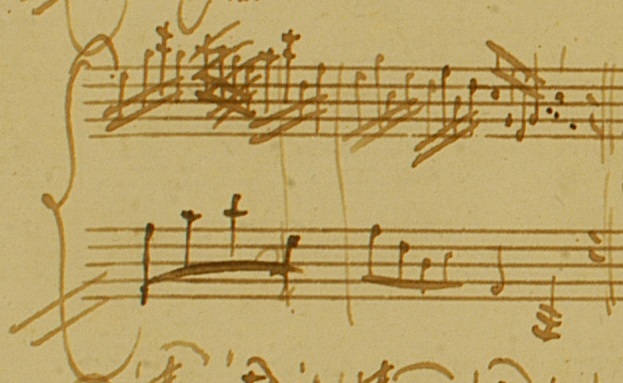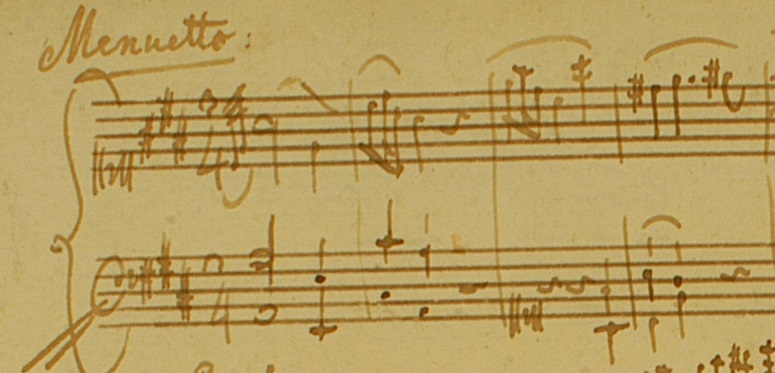 You presumably know Mozart’s A-major Piano Sonata KV 331 (with the “alla turca” rondo). One of the best-known sonatas, if not THE best-known, of the entire piano repertoire. And yet it is the bitter truth that to this day we all play this famous sonata incorrectly, not in any event like Mozart wanted it. How so? Up to now there has been no single error-free music edition of this famous piece. The 19th century had garbled the sonata almost beyond recognition: Urtext editions of the 20th century (even ours so far) have essentially had to make use of the first edition (“opus 6” in the Artaria publishing house, Vienna, 1784) as the best available basis for the text because Mozart’s autograph (up to the last page of the “alla turca”) was lost.
You presumably know Mozart’s A-major Piano Sonata KV 331 (with the “alla turca” rondo). One of the best-known sonatas, if not THE best-known, of the entire piano repertoire. And yet it is the bitter truth that to this day we all play this famous sonata incorrectly, not in any event like Mozart wanted it. How so? Up to now there has been no single error-free music edition of this famous piece. The 19th century had garbled the sonata almost beyond recognition: Urtext editions of the 20th century (even ours so far) have essentially had to make use of the first edition (“opus 6” in the Artaria publishing house, Vienna, 1784) as the best available basis for the text because Mozart’s autograph (up to the last page of the “alla turca”) was lost.
“Was” – but now, for the sensational! In September 2014, Balázs Mikusi, Head of the Music Department in the National Széchényi Library in Budapest, discovered a previously, totally-unknown double leaf of the famous A-major sonata written entirely in Mozart’s hand. It contains essential sections of the work (from the 3rd variation of movement 1, mm. 55 ff., up through m. 10 of the trio). Some of you will perhaps have followed the news coverage of this sensational find.
I was able to examine this Mozart autograph, study it intensively and make source comparisons – thanks to the generosity of Mr. Mikusi and his library. That’s why a completely revised Henle Urtext edition of Mozart’s A-major sonata will be available as of the beginning of June 2015. Then, essential sections of the sonata will exist for the first time in a well-grounded music text. And the music world will sit up and take notice: For a number of the notes have had to be corrected, innumerable details put straight. On the other hand, the newly-found autograph will confirm that several places in the text of the first edition always considered “problematic” were actually intended by Mozart.
To go into detail is beyond the scope of this blog posting. A few days ago we recorded in the publishing house a video interview with Professor Bellheim (artistic adviser for the new edition, who also provided the fingering) and myself (as editor). You will very soon be able to see this on our YouTube channel. But mentioned here in the blog are at least two of the randomly singled-out spots – just “to whet your appetite” a bit:
1st movement, variation VI, Allegro, measure 116, last note in the left hand: Here in all modern editions is a wrong A-major chord in the lower register. According to the autograph, the single note A1 in the autograph is correct:
2nd movement, Menuetto, measure 3, last note in the right hand: Here in all modern editions is a wrong quarter note c sharp3 (thus, also in the repeat in m. 33). According to the autograph it must be a2 (and with a full-measure slur):
You can look forward to the new Urtext edition. So, as already said: On sale as of the beginning of June 2015 (and anyone who really wants to be completely in the know, can find on the Henle website a detailed discussion of the “new” autograph and other primary sources for KV 331).
How popular especially the “Turkish March” is nowadays, is demonstrated by Aleksey Igudesman and Hyung-ki Joo.







I trust the research of the scholars who worked on this addition, but in the Menuetto example you mentioned (As seen in the image inside the post), it seems to me that Mozart indeed wrote c# and not A.
Thank you for your comment! But please be aware of the fact that troughout the Sonata (interestingly enough!) Mozart wrote the right hand part in the soprano-c-clef. So it is “a” and not “c#”. Do you agree?
Absolutely right. Just realized the c clef. Has Mozart done that before with other piano writing?
Has a recording been made yet, or scheduled?
I write for Gramophone, Strings, Seen and Heard International, and the Huffington Post.
That’s a good question. I am sure that there will be plans out there. Zoltán Kocsis already performed parts of the Sonata according to the newly discovered autograph on a copy of a Walter fortepiano in Budapest; here the 5th variation of mvmt. 1: https://www.youtube.com/watch?v=LAa-Tro_FPU
Congratulations to this project!
Concerning the use of the old soprano c-clef in this autograph: This is indeed very interesting. It seem’s to me, that Mozart used it as a kind of special exercise for (young) piano players in learning the old clefs. It is good old baroque tradition like Bach did also in some organ works. Especially organists should have this capacity also today.
This is fantastic! Has this discovery been verified to be authentic by reputable musicologists and music historians familiar with Mozart’s ouvre?
Regarding the C clefs, Mozart adhered the older tradition of using the soprano clef for the upper staff in the manuscripts of some of his piano sonatas, like K. 330, 331, and 332. Yet in others he used the G clef, as in K. 311 and 457. It appears that he was still not completely at home with the new style. All were first published using the G clef.
The “new” A natural and slurring seen in m. 3 of the minuet in the recently discovered manuscript simply confirms what is seen in the first edition by Artaria and is not a big surprise. The C sharp accepted by the NMA later editions may come from an early edition by Breitkopf. It is interesting that the old Breitkopf Mozart Complete Works may have suspected an error in m. 8 of the last variation of the first movement and has only the low A, not the low chord.